The Google Nexus 9 Review
by Joshua Ho & Ryan Smith on February 4, 2015 8:00 AM EST- Posted in
- Tablets
- HTC
- Project Denver
- Android
- Mobile
- NVIDIA
- Nexus 9
- Lollipop
- Android 5.0
Battery Life
It goes without saying that battery life is one of the most important aspects of a mobile device. After all, a mobile device isn’t really mobile if it can only be used for an hour before running out of battery. In order to test this, we turn to our standard suite of battery life tests, which include our web browser battery life test, along with some compute-bound benchmarks to characterize battery life across various use cases.
However, as the Nexus 9 introduces such a unique CPU architecture, I felt that it was necessary to try and adequately capture the full extent of battery life. To this end, I’ve introduced a new test that is really quite simple but important, as we can start to separate display power from everything else since it can often be the single largest consumer of power in a test. In order to do this, everything that could run during a test is disabled, and the device is placed in airplane mode with the display at 200 nits. A white image is displayed on the screen from a full charge until the device shuts down.
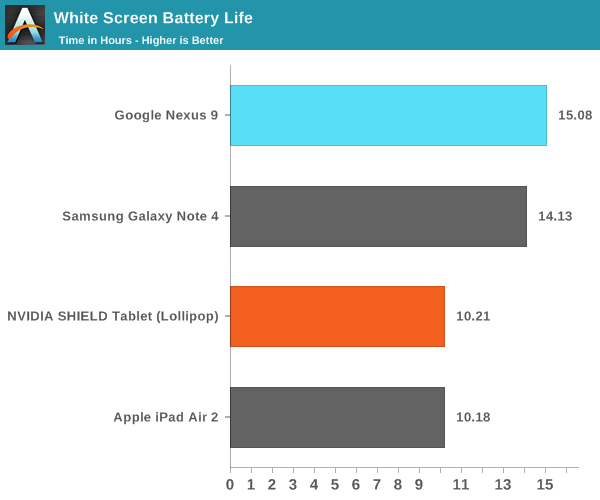
Interestingly enough, the display runtime on the Nexus 9 is about as good as it gets when compared to other devices for which we have data. I suspect we’re looking at the direct result of the large battery combined with an efficient display, as the Nexus 9 can last as long as 15 hours in this test compared to the iPad Air 2’s 10 hours.
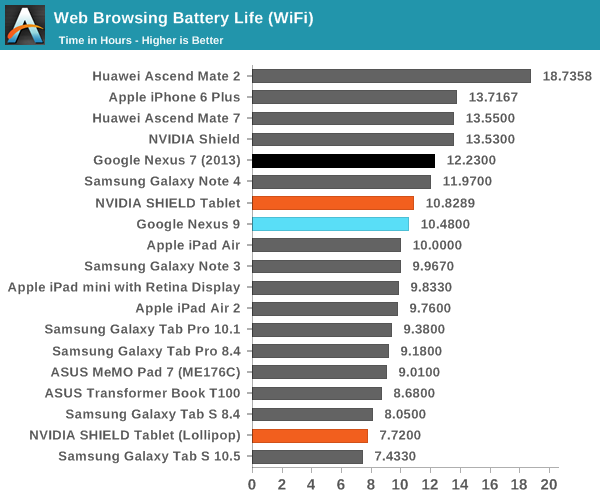
Unfortunately, the massive lead that we saw with the pure display test is significantly eroded in our web browser test. Our web test is primarily focused upon CPU, connectivity, and display efficiency. Seeing as how the Nexus 9’s display is far ahead of the iPad Air 2 and connectivity should be broadly similar in power efficiency, it seems that all of the efficiency gains from the display have gone into powering the Denver CPUs. It’s likely that process has a significant effect on this, so the more valid comparison is between SHIELD Tablet and the Nexus 9. At any rate, the Nexus 9 does manage to deliver solid battery life performance in this test which is definitely a good thing.
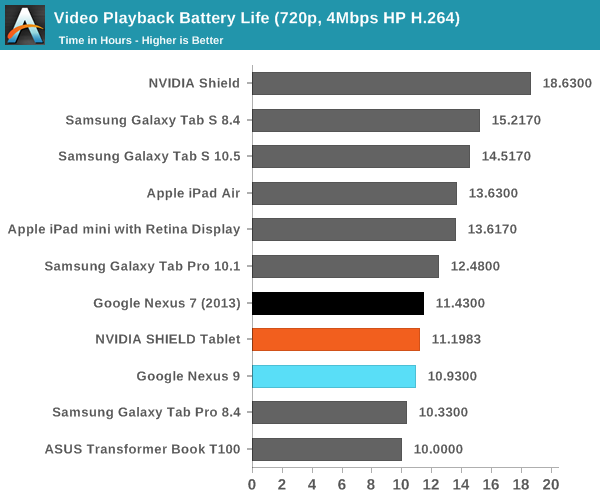
When we move to our pure video test, the Nexus 9 does have a minor regression when compared to the Nexus 7 (2013) and SHIELD Tablet. In this case, the AMOLED displays on the Galaxy Tab S line make for an easy victory due to the relatively high amount of black displayed in the content. The gap is closed between the two devices though, due to a reduced focus on SoC power.
While our web browsing test can give some idea of efficiency, there are often cases where more compute is directly used to support a better experience. To try and test for these compute-bound cases, we use Basemark OS II’s CPU battery life test and GFXBench’s T-Rex rundown for a GPU battery life test. As with the web browsing tests, these are run at 200 nits to keep things relatively equal.


In Basemark OS II, the Nexus 9 does a surprisingly good job as the CPU manages to keep incredibly high sustained performance. The large battery and efficient display seem to help to a significant extent.
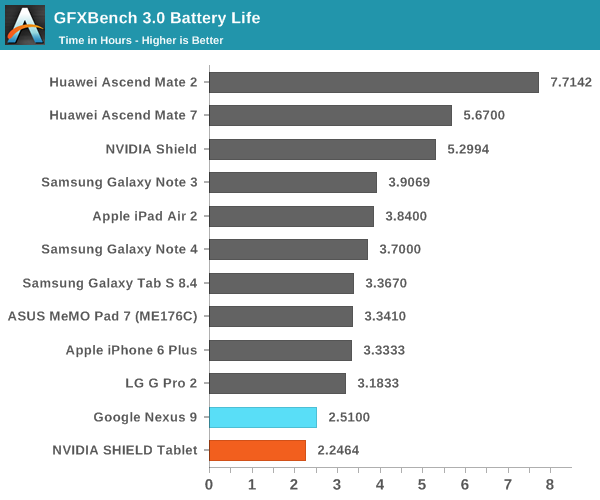
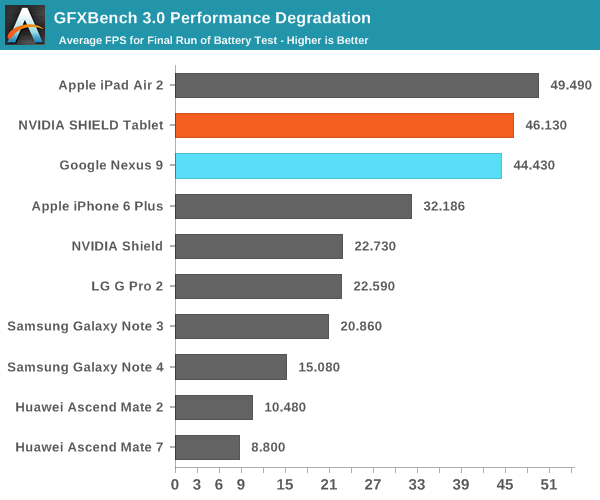
In GFXBench, it seems that not much changes overall. The GPU is definitely more power hungry than the PowerVR Series 6XT line-up and sustained performance is noticeably worse, but it’s in line with the SHIELD Tablet. End of run performance ends up a bit lower, but higher than one might expect. This is likely due to differing ambient temperatures. In practice, skin temperatures are about 45C in this test and localized to the top half of the device, and it’s likely that internal temperatures are around 80C as well. Seeing as how Tegra K1 can theoretically draw 33W in platforms such as the Jetson TK1 dev board with active cooling, it's incredibly impressive to see NVIDIA effectively keep such a powerful SoC within the constraints of a passively-cooled tablet.
Charge Time
While battery life is one part of the equation, charge time is an equally important aspect of overall battery life. To measure this, we measure the time from when charging begins to when the device reaches 100% charge. This is confirmed by taking measurements at the power outlet to make sure that power draw is below a certain level.
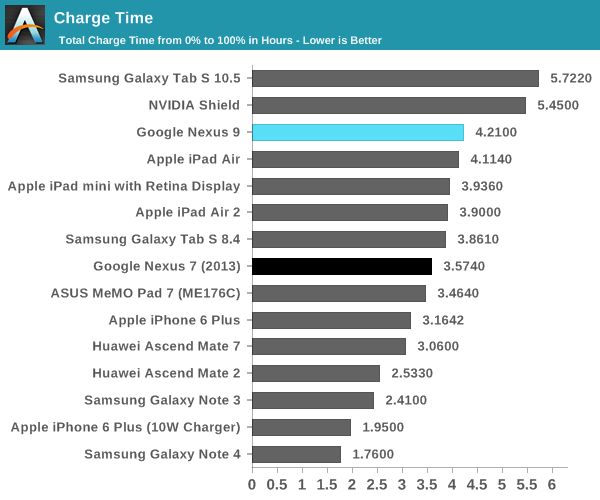
In this regard, the Nexus 9 is merely average for a tablet, although it does fall behind the competition as it uses a 5V, 1.5A charger for 7.5W instead of the 12-15W chargers that we’ve seen recently. It shouldn’t be a big issue, but in general this does mean that devices like the Galaxy Note 4 are actually better at battery life overall when compared to most tablets.










169 Comments
View All Comments
UtilityMax - Sunday, February 15, 2015 - link
I don't fully understand you comment about the SoC? You think web browser is using the hardware somewhat differently from the dedicated apps?My comment is about the fact that there is not point to have most of the dedicated apps when you have a tablet with a screen the size of a small laptop or netbook. Just fire up the web browser and use whatever web site you need. Most dedicated mobile apps exist because the screen size of a cell phone is pretty small, which can make for an awkward experience even when you pull a mobile web site though a web browser.
UtilityMax - Sunday, February 8, 2015 - link
It's not entirely true that there isn't much in the tablet space, besides Nexus 9 and Galaxy Tab S. If your pockets are deep enough, you could always get the Apple iPad Air 2. Apple gives you a well balanced tablet with great build quality, fine screen, CPU/GPU performance, and battery life. The only thing that's missing is an SD card slot, but at least there is an option a 64 or 128GB model. Personally, I ended buying a Tab S 10.5 because it was truly difficult to resist it at only $400 sale price, plus $35 for a 64GB SD card. Despite all the disappointing benchmarks, Tab S provides a pretty smooth and fluid android experience with a great screen. Battery life is the only thing that's getting on the way. Five hours of web browsing or standby is pretty disappointing.wintermute000 - Monday, February 9, 2015 - link
Sony Xperia Tablet Z2. SoC is one gen behind but if you can get it for a good price, you're laughing. Fantastic build, clean stock software, lag free.sunil5228 - Sunday, February 8, 2015 - link
Brilliant ! Esp loved the segway into the Denver CPU and dual vs quad arcitechture comparisons,very eye opening. thankyou sirbdiddytampa - Wednesday, February 11, 2015 - link
Picked one of these up a couple weeks ago and love it. It performs phenomenally well, and looks great. It's a bit heavy for its size and the thin bezel on the sides makes it difficult to hold with one hand without touching the screen, but overall its a fantastic tablet. Highly recommend it.Ozo - Monday, February 16, 2015 - link
Thanks for the lucid explanation of Denver.Any insight into why Google/HTC dropped the ball on "wireless" Qi charging? Especially when it was finally added to the Nexus phone!?!
I was set to upgrade from my Nexus 7 (2013), but no Qi = no sale. :(
Fardreit - Monday, February 23, 2015 - link
I'll be honest: I don't understand 80% of what the reviewer wrote. But the 20% that I do understand is enough for me to appreciate the conclusions drawn. I value the informed reviews here much more than those at the 'fan' websites. At Anandtech, people really know what they're talking about, even if I don't.When I'm able to follow the high-tech insults you guys sling at each other, then I know I've made progress.
flashbacck - Wednesday, February 25, 2015 - link
Does the Shield Tablet use a similar DCO? I have noticed during it has performance issues during regular use. I wonder if it's this DCO that still needs work.ahcox - Thursday, February 25, 2016 - link
What is the accuracy of the image labelled "K1-64 Die Shot Mock-up"? Is it a colorized and enhanced version of a real die photograph or is it a pure invention? That 16 * 12 array dominating the picture seems a little off to me: surely there should be structures common to each 16*2 group forming an SMX? Kepler is not a simple tiled sea of cores.